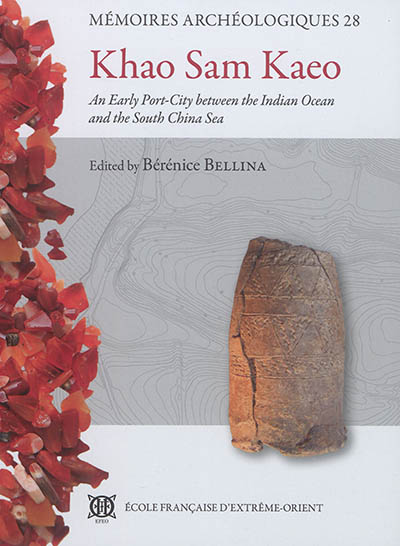en savoir plus

Carte fidélité
Permet à tous ses détenteurs d'obtenir 5% de réduction sur tous les livres lors du retrait en magasin (réduction non cumulable avec les réductions de type étudiant).
Offre également un certain nombre d'avantages auprès de nos partenaires.
Wishlist
Avec les favoris, retrouvez dans un espace les sélections effectuées au fur et à mesure de vos navigations dans le site.
Constituez pour votre usage personnel vos listes de livres en prévisions d'achats futurs et votre sélection d'articles, dossiers, événements, vidéos ou podcasts préférés ou à découvrir plus tard...
Il suffit simplement de cliquer sur "Ajout Favori" sur chaque page qui vous intéresse pour les retrouver ensuite dans votre espace personnel.
Requiert un compte Mollat
Mes Alertes
Requiert un compte Mollat
Khao Sam Kaeo : an early port-city between the Indian Ocean and the South China Sea
en savoir plus
Résumé
A partir des différents résultats des fouilles sur le site archéologique de Khao Sam Kaeo (isthme de Kra), des études sur les différentes cultures, les populations, la vie quotidienne ou encore le commerce de ce qui fut un véritable centre cosmopolite sur la route maritime de la soie. ©Electre 2024
Lire la Quatrième de couverture
Réduire la Quatrième de couverture
Mémoires archéologiques 28
An Early Port-City between the Indian Ocean and the South China Sea
Two thousand years ago, the Wu Emperor of China sent south a naval expedition to seek opportunities to increase trade. The leaders encountered a Southeast Asian kingdom, with an established government, laws, cities and flourishing trade with India and Rome. The expedition report survives in the Chinese dynastic archives, and poses a fascinating challenge to archaeologists : what was the nature of this maritime Silk Road, when did it begin, what manner of people ran it, and how did it affect their lives ?
Answers to these key questions are now emerging from five years of excavations and a decade of intense analyses that centre on the Kra Isthmus, the narrow neck of land that provides the easiest passage between the Indian Ocean and the South China Sea. Here, the trade route is dominated by the urban centre of Khao Sam Kaeo, a sprawling settlement atop four hills, next to the Tha Tapao River.
For the first time in Southeast Asia, a multidisciplinary project involving geoarchaeology, botany and metallurgy, combined with geographical information systems, has been deployed to unravel the timing of the emergence of the maritime Silk Road and its social impact. We have found that its origins are far earlier than suspected, stretching back into the 4th century BC. Over the centuries, Khao Sam Kaeo became a cosmopolitan hub that drew merchants and artisans from India and other Asian horizons. Gold and silver, carnelian and glass jewellery came from new workshops. In the fields beyond the city walls, new crops of Indian origin were grown alongside the traditional rice fields. Chinese ceramics, Vietnamese bronzes, even Roman tradewares made their way to the markets of Southeast Asia.
The vital importance of Khao Sam Kaeo in documenting and illuminating the early maritime trade is seen in the later rise of states like Pasai, Banten, Melaka and Ayutthaya. Here again, on a magnified scale, there were highly specialised manufacturing industries controlled by powerful kings. Revealing the deep seated cultural changes that took place at Khao Sam Kaeo thus illuminates for the first time a critical stage in the history of Southeast Asia.
Fiche Technique
Paru le : 01/09/2017
Thématique : Préhistoire
Auteur(s) : Non précisé.
Éditeur(s) :
Ecole française d'Extrême-Orient
Collection(s) : Mémoires archéologiques
Contributeur(s) : Directeur de publication : Bérénice Bellina
Série(s) : Non précisé.
ISBN : 978-2-85539-427-5
EAN13 : 9782855394275
Reliure : Broché
Pages : 674
Hauteur: 28.0 cm / Largeur 22.0 cm
Épaisseur: 4.3 cm
Poids: 2350 g
